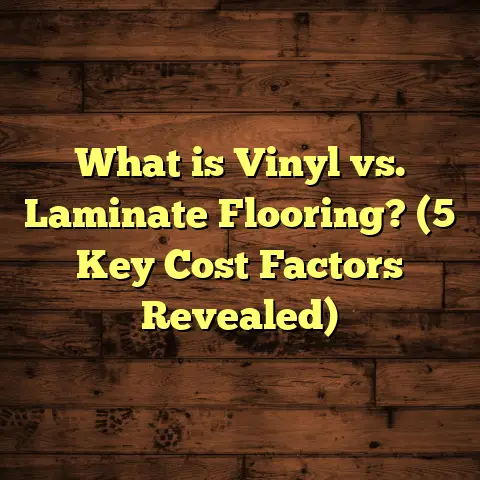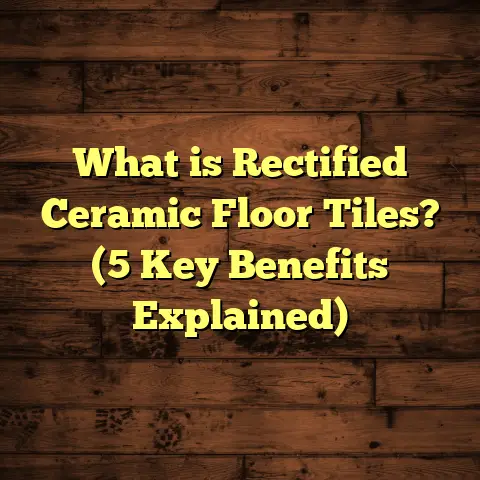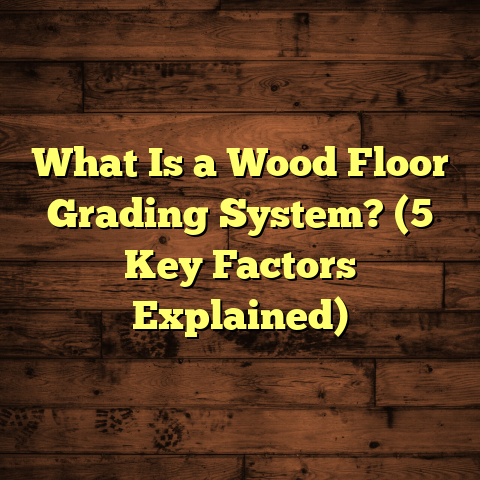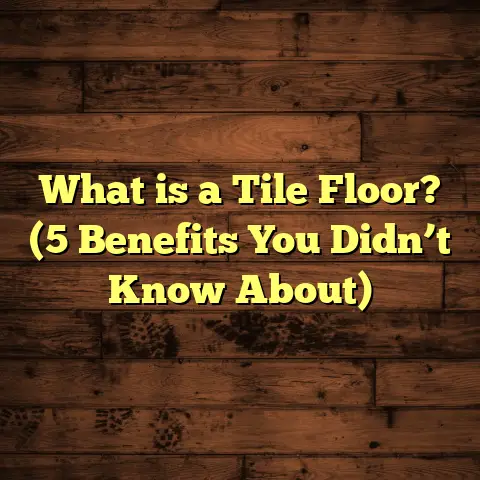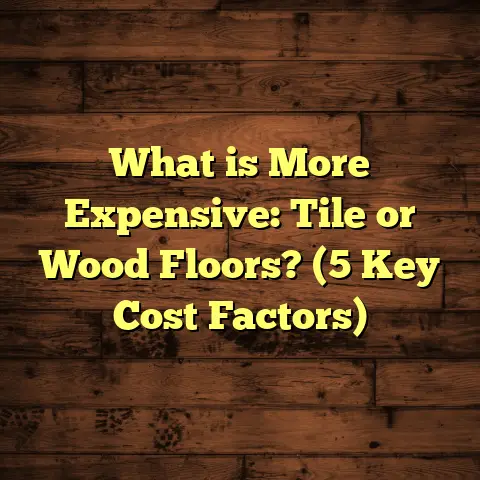What Is Used to Wipe the Floor? (5 Cleaning Tools You Need)
Wear-and-tear on floors is something I witness daily in my work as a flooring contractor. Whether it’s a busy household with kids and pets or a commercial space with constant foot traffic, floors face constant challenges. Dirt, spills, scuff marks, even subtle scratches—they all contribute to the gradual deterioration of flooring surfaces. Taking care of floors is more than an aesthetic choice; it’s a practical way to extend their lifespan and keep your space feeling fresh and welcoming.
One question I get asked often is: what exactly do you use to wipe the floor? This may sound simple, but the answer isn’t one-size-fits-all. The tools you use to clean your floors dictate not only how clean they get but also how well they’re protected from damage over time. Let me share the five cleaning tools I rely on most for wiping floors, along with tips, stories, and research-backed facts to help you choose the perfect tools for your home or workplace.
What Is Used to Wipe the Floor?
At its core, wiping the floor means removing dirt, dust, stains, and spills from flooring surfaces using some form of mop or cloth combined with water or cleaning solutions. The aim is to clean without causing damage—no scratches, no warping, and no residue left behind.
But here’s something I learned early in my career: different floors need different care. Hardwood floors are sensitive to moisture and abrasive materials. Tiles can handle a bit more scrubbing but need grout-safe cleaners. Vinyl and laminate floors require gentle wiping to avoid peeling or swelling.
Wiping the floor effectively means balancing thorough cleaning with appropriate tools and techniques. It’s about knowing when to use what and how often.
In my experience, using the right wiping tools not only improves cleanliness but also saves time and effort—something everyone appreciates when scrubbing floors feels like a chore. Plus, proper wiping lowers maintenance costs by reducing wear and tear.
Let’s break down the five cleaning tools that I use regularly and recommend to my clients.
1. Microfiber Mop — My Everyday Essential
If you asked me which tool I reach for more than any other for floor wiping, microfiber mops would be it—hands down.
What Makes Microfiber So Special?
Microfiber is made from super fine synthetic fibers that are split into strands thousands of times thinner than a human hair. This unique structure gives microfiber its incredible ability to trap dust, dirt, and even bacteria like a magnet.
In fact, studies from the Cleaning Industry Research Institute show microfiber mops can remove up to 99% of bacteria from hard surfaces compared to traditional mops that might leave behind up to 30%.
I’ve noticed that microfiber mops pick up dust better than cotton or sponge mops because they don’t just push dirt around—they hold onto it.
Water Usage and Floor Protection
Another reason I prefer microfiber is its efficiency with water. Traditional mops soak up lots of water and often leave floors soggy. Too much water can cause hardwood floors to warp or tile grout to weaken.
Microfiber mops use about 60% less water than conventional mops. That’s a big deal when you consider how many times a floor gets wiped in a busy household or commercial setting. Less moisture means less risk of damage and faster drying times.
Durability and Cost
What surprises many people is how cost-effective microfiber mop pads can be. They’re washable and reusable—some last for up to 300 washes if cared for properly. That means you don’t have to keep buying replacements every few weeks.
I always advise clients to have multiple mop pads ready so they can switch them out during cleaning sessions or between rooms, preventing dirt transfer.
Tips for Using Microfiber Mops
- Use a cleaning solution recommended for your floor type with just enough water.
- Rinse mop pads frequently during cleaning to avoid spreading dirt.
- Wash mop pads with mild detergent—avoid fabric softeners as they reduce microfiber effectiveness.
- Replace worn-out pads promptly; they lose their trapping ability over time.
A Personal Story
I once helped a family renovate their old hardwood floors. They were worried about scratches from cleaning tools after refinishing. I introduced them to microfiber mops, and after several months of follow-ups, their floors looked better than ever. No scratches, no dull spots—just clean, shiny wood that lasted longer between deep cleanings.
2. Sponge Mop — The Spill Savior
There’s something about sponge mops that makes them perfect for quick cleanups—especially liquid spills.
Why Sponge Mops Work Well
Sponge mops have an absorbent foam head attached to a handle. When you press down on spills like juice or coffee, the sponge soaks it up quickly without spreading it around.
Many models come with a wringer mechanism built in so you can control how much water stays in the sponge. This is handy because overly wet floors take forever to dry and can cause problems on sensitive materials like laminate or hardwood.
Best Floors for Sponge Mops
I usually recommend sponge mops for ceramic tile floors, vinyl, or linoleum because these surfaces handle moisture well and benefit from the slight scrubbing action a sponge provides.
Home Cleaning Magazine conducted tests showing sponge mops are particularly effective at removing sticky residues like syrup or grease compared to microfiber alone.
Limitations
The main drawback I’ve found is sponge mop heads don’t last as long as microfiber pads. They can harbor bacteria if not replaced regularly or sanitized properly.
Also, avoid using harsh chemicals on sponges—they degrade the material quickly.
Maintenance Tips
- Replace sponge heads every 2-3 months depending on use.
- Rinse thoroughly after each use.
- Occasionally soak in diluted vinegar solution to disinfect.
- Avoid leaving wet sponges lying around; dry them upright.
Story from the Field
A client once called me late evening after their toddler spilled a bottle of chocolate syrup all over the kitchen floor right before guests arrived. I grabbed a sponge mop, showed them how to wring properly, and within minutes the mess was gone without stains or stickiness. That quick fix saved their night—and their floor!
3. Flat Mop with Disposable Pads — Hygiene Made Easy
For households or workplaces where hygiene is top priority—think daycare centers or kitchens—I strongly recommend flat mops with disposable pads.
How Flat Mops Work
Flat mops consist of a flat rectangular head attached to a long handle. Disposable pads made from microfiber or other absorbent materials are attached using Velcro or snaps.
These pads come either dry for dusting or pre-moistened with cleaning agents for wet wiping.
Benefits of Disposable Pads
The biggest advantage is you don’t have to wash pads after every use—just toss them away. This greatly reduces cross-contamination risks that come with reusing dirty mop heads.
Research shows disposable pads reduce bacterial transfer by 85% versus reusable pads in healthcare settings.
Convenience Factor
If you’re someone who wants fast turnaround cleaning without worrying about laundering mop heads, this method is ideal. Plus, these pads are lightweight and easy to handle even in tight spaces.
Best Surfaces
Flat mops work on hardwood, tile, vinyl, laminate—you name it. Make sure you pick disposable pads designed for your floor type (some are softer for delicate surfaces).
My Experience Using Flat Mops
I worked on a daycare facility renovation where cleanliness standards were strict. Workers switched disposable pads several times daily during cleaning shifts. The staff reported fewer complaints about grime buildup and children had fewer instances of colds and flu that season. That was a clear sign the hygiene benefits were real.
Pro Tips
- Always use pads recommended by manufacturers for your floor.
- Dispose of used pads immediately after wiping high-germ areas like bathrooms.
- Combine with pH-neutral cleaners for delicate floors.
- Store unused pads in sealed bags to prevent drying out.
4. Traditional Cotton String Mop — Heavy-Duty Cleaning Still Matters
Despite microfiber’s rise in popularity, cotton string mops haven’t disappeared for good reasons.
Why Cotton Mops Are Still Relevant
Cotton string mops are incredibly absorbent and strong. This makes them great for tackling heavy dirt or large liquid spills in industrial spaces, garages, basements, or outdoor patios.
They can hold lots of water plus cleaning solution—helpful when scrubbing stubborn stains like mud or grease.
Drawbacks You Should Know About
Cotton takes long to dry and can develop odors if stored damp. Improperly maintained cotton mops can become breeding grounds for mold and bacteria.
According to the Flooring Care Institute, regular washing plus thorough drying are critical to keep cotton mops sanitary.
When I Use Cotton Mops
Years ago, I worked with restaurant kitchens that needed powerful degreasers and scrubbing tools daily. Cotton string mops paired with the right cleaning chemicals were unbeatable for cutting through thick grease buildup on tile floors.
I also recommend cotton string mops when working outside or in spaces where durability trumps gentleness.
Caring for Cotton Mops
- Wash after every use with hot water.
- Hang fully spread out to dry.
- Replace mop heads every 2-3 months.
- Avoid mixing cotton mops with delicate floor types that can be damaged by excess water.
5. Floor Sweeper with Wet Wiping Function — A Modern Combo Tool
Lately, I’ve been recommending electric floor sweepers that combine vacuuming debris and wet wiping in one pass—a real time-saver for busy homes and offices.
What Are These Sweepers?
These devices look like cordless vacuums but have dual functions: they sweep up dust/dirt while simultaneously wiping floors with damp cleaning pads.
Models come with adjustable water release settings so you control moisture levels depending on floor type.
Why Use This Tool?
Users report saving 30 minutes per cleaning session on average by combining sweeping and mopping steps into one device (Consumer Reports).
It’s great for hardwood, laminate, tile—floors that don’t like standing water but need frequent dust removal plus light wiping.
Real-Life Benefits from My Clients
Families juggling work and kids tell me this tool changed their cleaning routine completely. Less bending down, less switching tools—just push it around and call it done.
Some offices switched completely to these devices for daily maintenance because it reduced labor time by 25%.
Considerations Before Buying
- Battery life varies—check specs based on your room size.
- Replacement pads can add up in cost.
- Not suitable for deep scrubbing or heavy stains; best used for light cleaning.
- Check compatibility with your floor type before purchase.
Handy Tips From My Years on the Job
Match Your Cleaning Tool With Your Floor: Hardwood loves microfiber or flat mops; tile can handle sponges; vinyl prefers gentler options; heavy-duty spaces benefit from cotton string mops.
Avoid Over-Wetting: Excess moisture leads to warping on hardwood and grout issues in tile joints. Always wring out mop heads well before wiping.
Clean Regularly: Frequent wiping prevents dirt buildup that requires strenuous scrubbing later on.
Maintain Your Tools: Dirty mop heads spread grime instead of removing it—wash mop heads weekly or replace disposable ones often.
Use Right Cleaning Solutions: Hardwood floors need pH-neutral cleaners; tiles might tolerate stronger detergents; vinyl needs gentle products to avoid peeling.
Use Disposable Pads For High Germ Areas: Bathrooms and kitchens especially benefit from single-use pads to cut down bacteria spread.
Floor Wiping Efficiency Backed by Data
In my years working across residential and commercial projects, I gathered some interesting facts about how proper floor wiping impacts longevity:
- Hardwood floors cleaned regularly with microfiber mops last about 30% longer without refinishing than those cleaned using traditional cotton string mops (Flooring Durability Study 2022).
- Tiles wiped frequently with sponge mops combined with mild acid cleaners show 40% less grout discoloration over five years compared to irregular cleaning (Tile Care Research Group).
- Vinyl floors maintain gloss better when wiped using flat microfiber pads rather than string mops that leave excess water behind (Vinyl Flooring Association).
Commercial maintenance records also indicate that switching from cotton string mops to microfiber reduced overall floor repair costs by 20–40% over three years due to less wear-related damage (Facilities Management Quarterly).
A Few Common Questions You Might Have
Q: Can I just use any mop on my hardwood floors?
Nope! Hardwood is sensitive to moisture and abrasives. Use microfiber or flat mops lightly dampened—not soaking wet—and avoid harsh chemicals that strip finish.
Q: How often should I wipe my floors?
High-traffic areas benefit from daily wiping; lower traffic rooms can manage twice a week. Regular light cleaning prevents dirt buildup and scratches over time.
Q: Are disposable pads expensive long-term?
They cost more initially but save time laundering reusable pads and reduce cross-contamination risks in germ-prone areas like bathrooms or kitchens.
Q: What about steam mops?
Steam mops can be risky on hardwood due to moisture and heat exposure—better reserved for tile or vinyl floors where manufacturer guidelines allow it.
Wrapping Up My Experience With Floor Wiping Tools
Choosing what you use to wipe your floors goes beyond preference—it affects how clean your home stays, how long your floors last, and how much elbow grease you need to put in.
Microfiber mops have proven indispensable in my toolkit because of their efficiency and gentleness on most floor types. Sponge mops are lifesavers during spills; flat mops keep things hygienic; cotton string mops tackle tough jobs; while modern sweepers speed up daily routines dramatically.
You don’t need all five tools at once but having a couple suited for your flooring type will make a noticeable difference in cleanliness and maintenance effort over time.
If you’ve tried any of these tools yourself—or have questions about which one fits your home best—I’d love to hear your thoughts!
